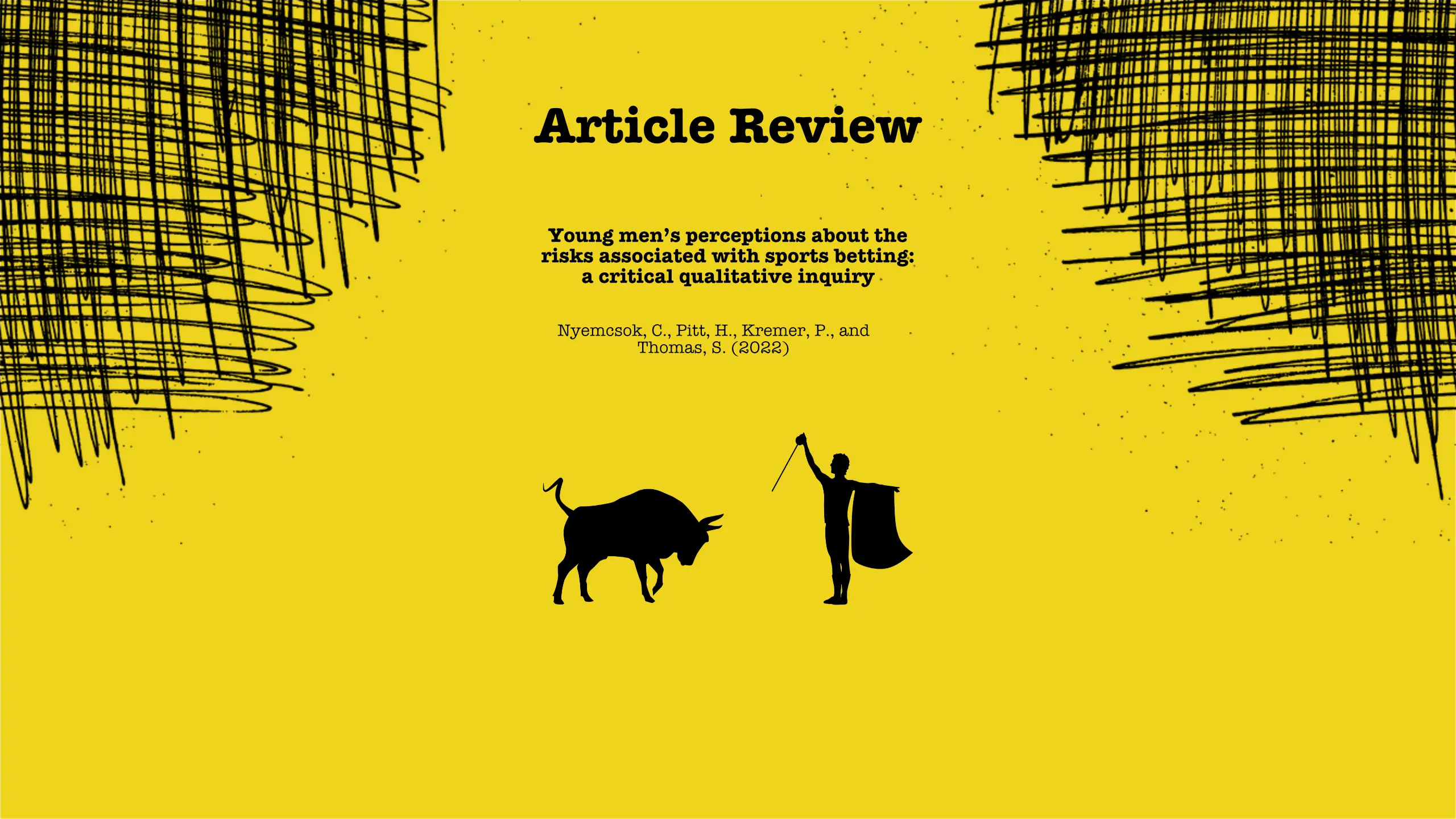Young men remain the group most associated with sports gambling, making their perception of risk a critical factor in understanding and preventing gambling-related harm. In Young Men’s Perceptions About the Risks Associated with Sports Betting: A Critical Qualitative Inquiry (Nyemcsok et al., 2022), the authors examine how socio-cultural and commercial influences shape young men’s understanding of gambling risk and how these factors normalize betting as part of everyday life.
The study highlights how beliefs in knowledge, skill, and control over sporting outcomes — often reinforced by advertising — lower risk perception and encourage riskier betting behaviors. It also emphasizes that gambling harm prevention should go beyond the individual level and address the social and commercial ecosystems that sustain gambling normalization.
Key Ideas
1. The normalization of gambling
One of the main threats identified is the normalization of betting within the daily routines of young men.
Through peer interactions, family traditions, and sports culture, gambling becomes an accepted and even celebrated activity. Social networks — both offline and online — perpetuate this normalization by embedding gambling into conversations, group chats, and social rituals.
The authors argue that gambling policies must go beyond individual responsibility and address structural and environmental factors that promote gambling normalization.
2. Socio-cultural and commercial influences
The study categorizes gambling risk factors into two main domains:
Socio-cultural factors:
- Family and peers: Informal gambling with relatives and friends introduces young men to betting at an early age.
- Social learning: Peers and networks often act as educators, teaching technical betting terms, odds, and markets (e.g., “la quinella”).
- Group competition: Friendly rivalry encourages higher betting frequency and value.
- Contextual acceptance: Betting occurs naturally in recreational spaces like pubs, sporting events, workplaces, or universities.
Commercial factors:
- Advertising and promotions: Sports gambling ads deliberately shift focus from risk to knowledge, skill, and control, framing betting as a rational and skill-based pursuit rather than a chance-based one.
- Promotional offers and odds deals: Create the illusion of “taking advantage” of market discrepancies, reinforcing perceived control.
- Fantasy sports leagues: Function as entry points, increasing perceived control and potentially bridging participation into real-money gambling.
3. Methodology
The research was conducted with 16 Australian men aged 18–24, using in-depth qualitative interviews held between February and November 2020.
A convenience and snowball sampling approach was used to recruit participants, enabling the researchers to explore lived experiences and social dynamics in detail.
Participants frequently cited motivations such as:
- The hope of making money,
- Relieving boredom,
- Demonstrating sports knowledge,
- Social competition and group belonging.
These findings underscore how social identity and peer validation play a central role in shaping betting behaviors.
4. The illusion of control and perceived risk
Beliefs in personal knowledge and skill create a false sense of control, leading gamblers to underestimate risks.
According to Zinn (2019), individuals with low or high perceived control may take risks to validate or restore that control — a mechanism clearly observed in sports betting.
Participants often viewed specific markets, such as “same game multis,” as “low risk, high reward” options due to their perceived ability to predict multiple outcomes based on sporting expertise. This cognitive distortion further reduces risk perception.
5. The role of social media and online communities
Digital and social platforms intensify exposure to gambling-related content.
Participants described receiving constant nudges from group chats and sports communities, making it difficult to disconnect from betting discussions.
These ongoing interactions sustain engagement and normalize gambling talk, even outside active betting moments.
The result is a persistent psychological presence of gambling within social life, blurring the distinction between recreational sports engagement and financial risk-taking.
6. Implications for harm prevention
To effectively reduce gambling harm among young men, interventions should:
- Incorporate social network dynamics into public health strategies.
- Challenge the myth of skill-based control and highlight the role of chance.
- Ensure that gambling advertisements include evidence-based risk information and do not misrepresent betting as a safe or skill-dominated activity.
- Foster critical media literacy to counter commercial narratives that glamorize betting.
Understanding risk perception through social and commercial lenses provides an essential foundation for developing culturally relevant, evidence-informed prevention policies.
Selected Citations
- “I guess technically we used to put money on for these fantasy ones as well. I guess it helped me increase the knowledge of some of the players and teams.”
- “Factors such as gambling marketing influence young people's beliefs about risk and future gambling intentions.” (Djohari et al., 2019; Bestman et al., 2019; Pitt et al., 2017)
Academic Reference
Nyemcsok, C., Pitt, H., Kremer, P., & Thomas, S. (2022). Young Men’s Perceptions About the Risks Associated with Sports Betting: A Critical Qualitative Inquiry. BMC Public Health, 22.
External References
- Bestman, A., Thomas, S., Pitt, H., Randle, M., & Daube, M. (2019). Exploring Children’s Experiences in Community Gambling Venues: A Qualitative Study with Children Aged 6–16 in Regional New South Wales. Health Promotion Journal of Australia, 30(3).
- Djohari, N., Weston, G., Cassidy, R., Wemyss, M., & Thomas, S. (2019). Recall and Awareness of Gambling Advertising and Sponsorship in Sport in the UK: A Study of Young People and Adults. Harm Reduction Journal, 16(1).
- Pitt, H., Thomas, S., Bestman, A., Daube, M., & Derevensky, J. (2017). Factors That Influence Children’s Gambling Attitudes and Consumption Intentions: Lessons for Gambling Harm Prevention Research, Policies and Advocacy Strategies. Harm Reduction Journal, 14(1).
- Zinn, J. (2019). The Meaning of Risk-Taking – Key Concepts and Dimensions. Journal of Risk Research, 22(1).
